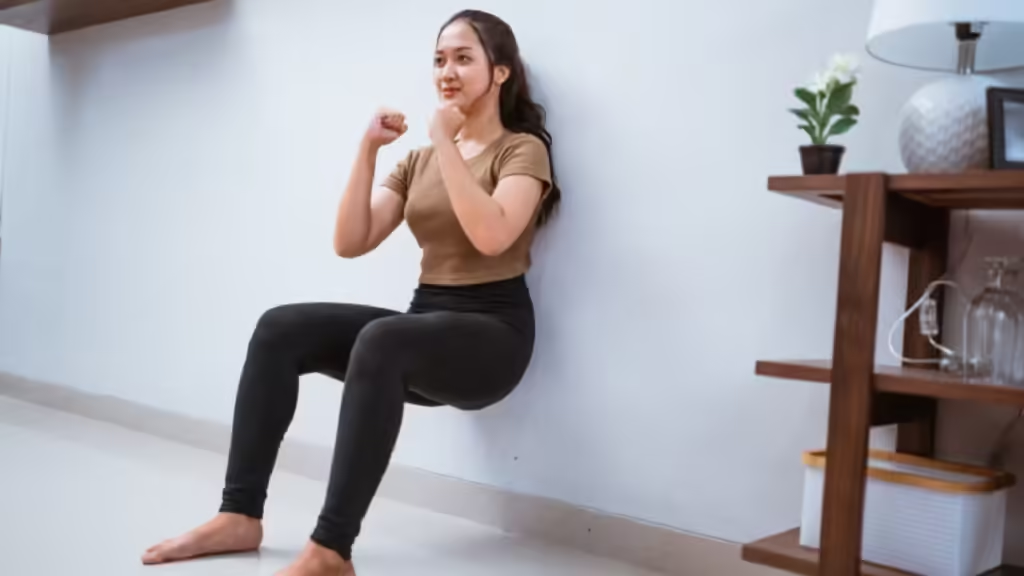Hello, Beautiful People! You want to maintain good posture? Wall exercises are best for you. They provide an original solution to solve these phase.
By utilizing the wall as a stable support, you can increase your posture and flexibility. It helps to reduce common issues such as back pain.
Either you’re working from home or at the gym, involving wall exercises into your routine can provide a lot of advantages. In this guide, we’ll learn about effective wall exercises planned to make your posture better. It will also increase your flexibility.
Let’s begin!
The Role of Posture and Flexibility in Overall Health

We’ll start y understanding the role of good posture. It is the base to overall health and well-being. It has following advantages:
- Supports the spine’s natural alignment
- Reducing strain on muscles and ligaments
- Prevent back pain
- Increases breathing
- Balanced distribution of weight
- Reduces the risk of injury.
Flexibility, on the other hand, makes better the range of motion in joints and muscles. It helps in injury prevention and increasing physical performance. It allows for smoother movements, which can reduce discomfort from repetitive activities.
Together, good posture and flexibility take part to a more active, pain-free lifestyle. It support better functional movement in daily life.
Why Wall Exercises?
I guess you’re thinking that why are we studying wall exercises, let me explain this for you. Wall exercises are fun and they make better posture and flexibility. The wall is used as a stable support. This stability allows for better control and precision during movements. It makes easier to maintain proper form and alignment.
In addition to that, the wall helps to guide your range of motion. This can be favorable for starters or those getting better from injuries.
Using the wall as an pillar provides a gentle resistance. This increases muscle involvement. This makes wall exercises easy to access for individuals at different fitness levels.
Their simplicity allows for efficient workouts even in small spaces. Including wall exercises into your routine can cause:
- Improved posture
- increased flexibility
- Balanced body.
https://youtu.be/h0RTa7wjFkE?si=7dUGmsnz0yirlRMG
Innovative Wall Exercises for Better Posture
Okay, now we’ll discuss some innovative wall exercises. Do share with me which one you liked the most.
Wall Angels
The first one is Wall Angels. This exercise helps open up the chest. This makes upper back posture better. In this exercise, you need to stand with your back against the wall.
Press your lower back and head against the wall. Lift up your arms to form a “W” shape with elbows curved at 90 degrees. Slowly move your arms up to form a “Y” shape, then return to the “W” position. Repeat this for 10-15 times.
Wall Slides
The second one is Wall Slides. They makes stronger the upper back and increase posture. In this exercise, you need to stand with your back against the wall and feet a few inches away. Now, press your lower back, shoulders, and head against the wall.
Curve your elbows to 90 degrees and put your arms against the wall in a “W” shape. Slowly slide your arms up to form a “Y” shape, then slide back down. Do this for 10-15 repetitions.
Chest Stretch Against the Wall
This stretch focuses on the chest muscles. They can help open up the shoulders, cancel out poor posture from sitting.
In this exercise, you need to stand next to a wall. Your elbow should be at shoulder height. Now, move your body away from the wall till you feel a stretch in your chest and shoulder. Stay for 20-30 seconds, then change sides.
Wall Lean
This exercise makes posture better. It strengthens the muscles along the spine. In this exercise, you need tp stand with your back against the wall. Your feet should be at a little distance.
Now, press your lower back, shoulders, and head against the wall. Involve your core and try to maintain this position for 30 seconds to 1 minute. Repeat 2-3 times.
Wall-Backed Squats
This difference of squats helps support proper alignment and balance. In this exercise, you need to stand with your back against the wall. Move down the wall into a squat position, making sure your knees do not expand past your toes. Hold the squat for a few seconds before sliding back up. Perform 10-15 repetitions.
Including these wall exercises into your routine can help correct posture imbalances. This will:
- Promote a healthier alignment
- Better posture
- Reduced discomfort.
Benefits of Wall Exercises
Postural Correction: Wall exercises help correct posture. For example, exercises like Wall Angels can help activate muscles that support the upper back and shoulders.
Increased Flexibility: By stretching muscles with the help of the wall, you can safely increase your motion. They help lengthen muscles in a controlled manner and improve overall flexibility.
Injury Prevention: Regular practice of wall exercises can help stop injuries. It makes muscle strength, joint stability, and balance better. Proper posture reduce the risk of sprains.
✅ Good posture = reduced risk of falls, less neck and back pain, improved range of movement, better balance, reduced fatigue.
Here are 3 exercises you can practice to help improve posture:
1️⃣ Wall angels
2️⃣ Thoracic rotation
3️⃣ Seated thoracic extension pic.twitter.com/gk494jYNwf— Bounce Back Exercise (@BBExercise) July 11, 2024
Detailed Instructions for Each Exercise
Wall Angels
It makes better shoulder mobility and upper back strength. In this exercise, you need to stand with your back fully against the wall. This will make sure your lower back, shoulders, and your head should touch the wall.
Start with your arms fold at 90 degrees, elbows at shoulder height, and press the backs of your hands and arms against the wall. Slowly lift up your arms while keeping them in contact with the wall. Bring them down back to the starting point and repeat.
Wall Slides
It increases shoulder and upper back strength. Place yourself against the wall with your back straight and feet a few inches away. Press your lower back, shoulders, and head strongly against the wall.
Fold your elbows to 90 degrees. After that, press your arms against the wall in a “W” shape. Move your arms up to form a “Y” shape. Make sure your elbows and wrists remain in contact with the wall. Come back to the starting position and repeat.
Chest Stretch Against the Wall
Opens up the chest and replace tightness in the shoulders. In this exercise, you need to stand side-on to the wall with one forearm pressed against it.
Place your elbow at shoulder height and slowly revolve your body away from the wall. Grasp the stretch, then change sides.
Wall Lean
It makes stronger core muscles and increases proper alignment. You need to stand with your back flat against the wall. Involve your core and press your lower back, shoulders, and head strongly against the wall.
Carry this position for 30 seconds. Also, focus on maintaining a straight posture.
Wall-Backed Squats
It makes better lower body strength and increases proper squat form. With your back against the wall, place your feet hip-width at a distance.
Slip down the wall till your thighs are side by side to the floor. Now, make sure your knees stay lined up with your toes. Grip the squat position for a few seconds before slipping back up to the starting position.
Tips for Effective Practice
Consistency
Regular practice is key to seeing betterments in posture and flexibility. Try to include wall exercises into your routine at least 3-4 times a week.
Form and Technique
Focus on maintaining proper form throughout each exercise. This makes sure you focus on the right muscles and avoid major injuries.
Breathing
Pay attention to your breathing. Breathe deeply during exercises to help relax your muscle.
Progress Tracking
Monitor your progress by observing any changes in flexibility and posture. You can use a mirror or take photos to visually see betterments.
Conclusion
Including innovative wall exercises into your routine can increase your posture and flexibility. All you need to do is use the wall as a support. By reinforce practicing above exercises, you can strengthen main muscle groups. You can get relieve from discomfort.
Including these exercises into your daily routine not only promotes better posture but also increases flexibility and body recognition. Perform these powerful exercises, and you’ll enjoy a healthier, more balanced life.
Let me know which exercise you loved the most?
FAQ
1. What are the advantages of wall exercises?
Wall exercises makes posture better by:
- Increasing alignment
- Strengthening muscle groups
- Increase flexibility
- Reduced discomfort
- Better mobility
- More balanced body.
2. How many times should I do wall exercises?
For best results, try to perform wall exercises 3-4 times a week. Consistency is main factor, so include them into your routine and then increase the frequency as you become more comfortable.
3. Can beginners do wall exercises?
Yes, wall exercises are best for starters due to their support and controlled nature. They help you learn proper form and build strength and flexibility.
4. How long should I hold stretch during wall exercises?
You need to hold stretch for 20-30 seconds. This allows your muscles to relax. For exercises involving strength, try for 10-15 repetitions.
5. Do I need any special tools for wall exercises?
No special equipment is required. All you need is a flat wall and enough space to perform the exercises. But yes, a yoga mat can provide additional comfort during exercises on floor.



